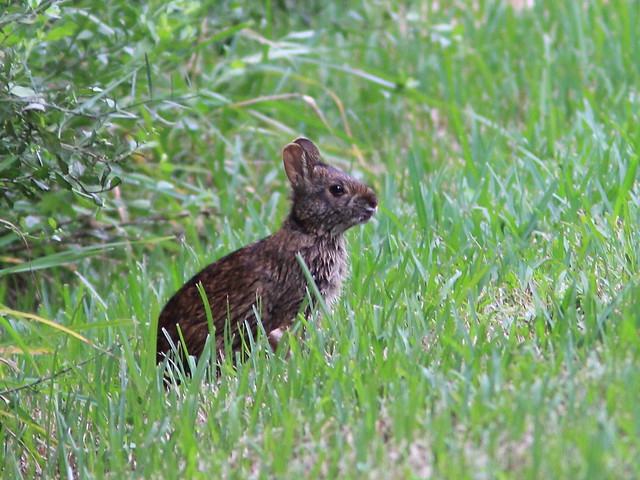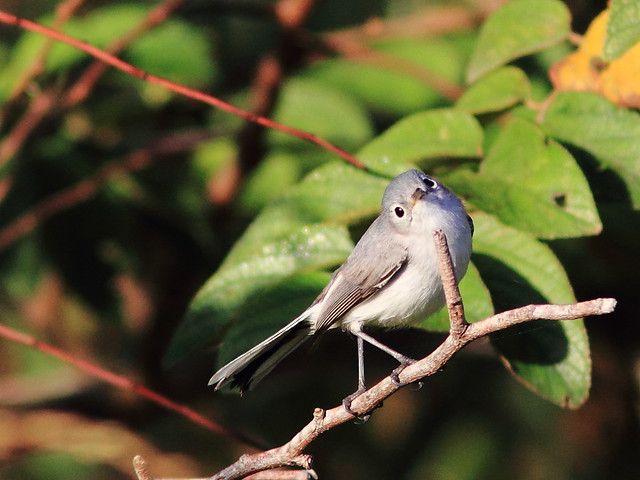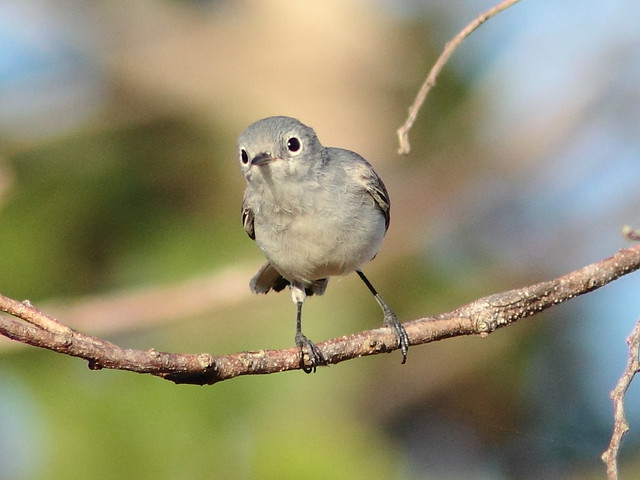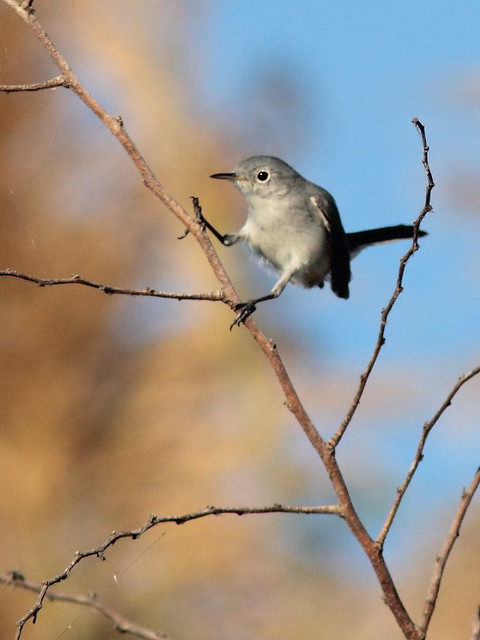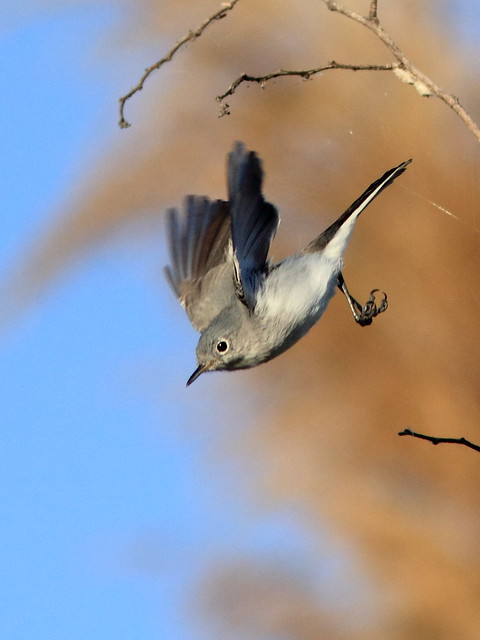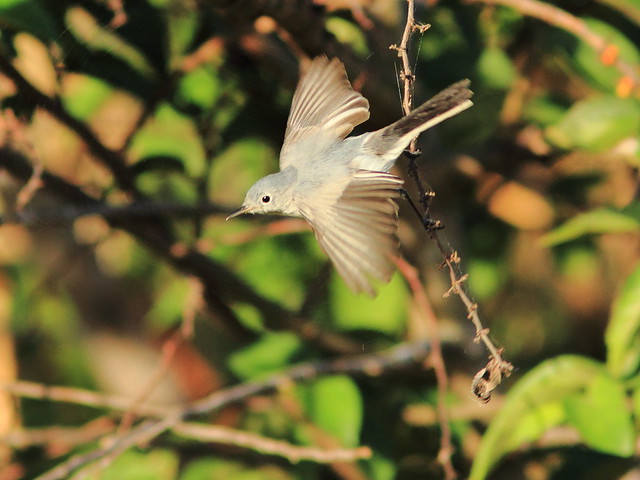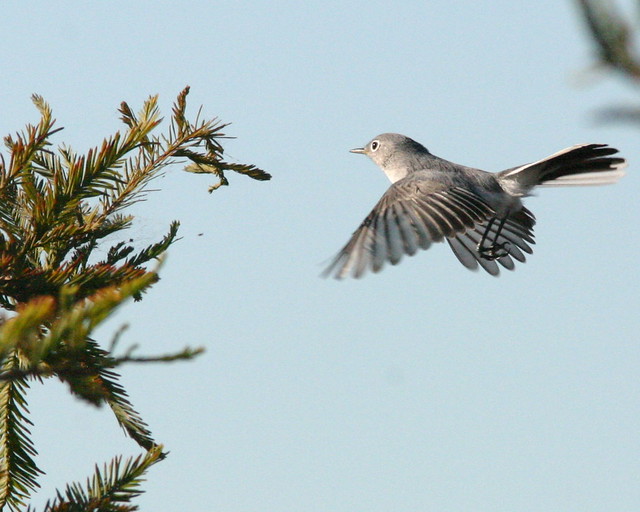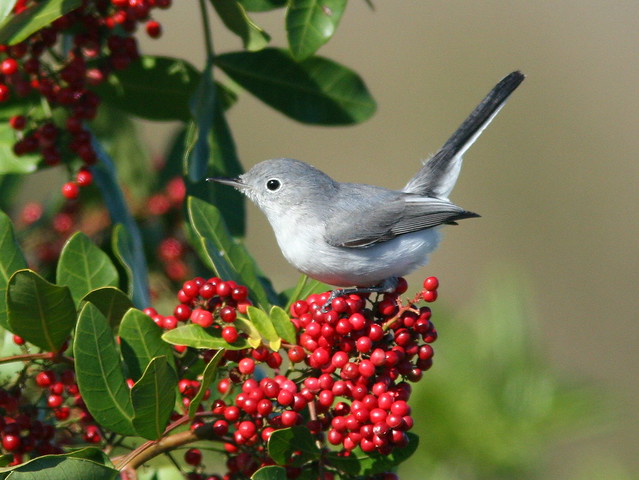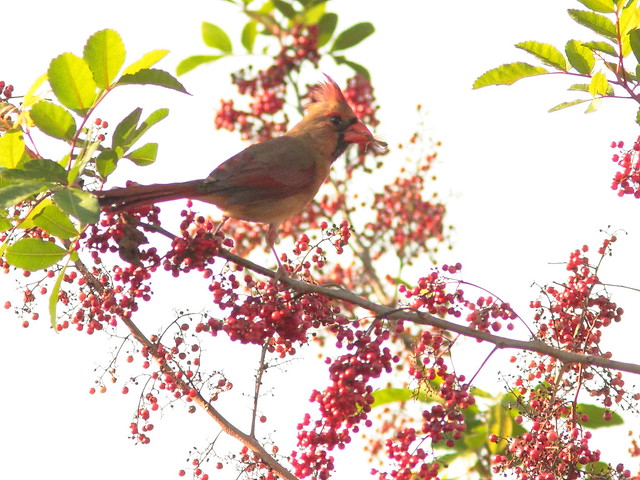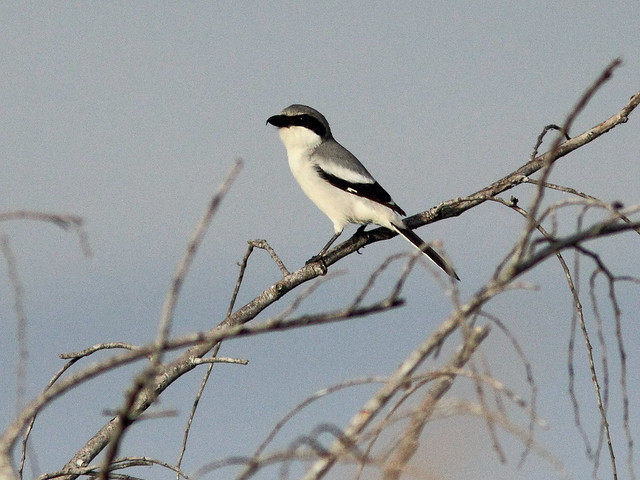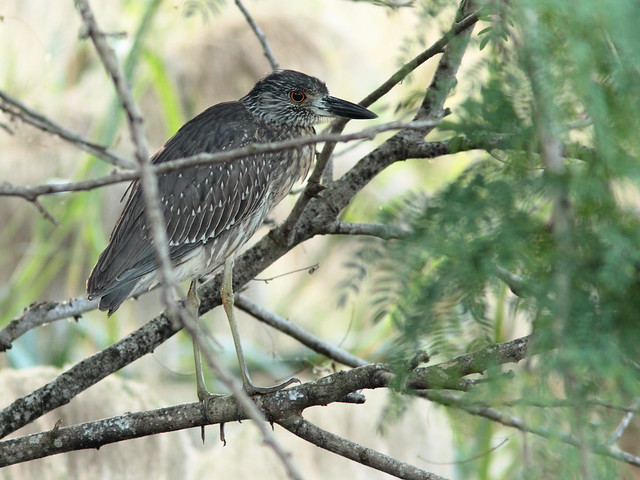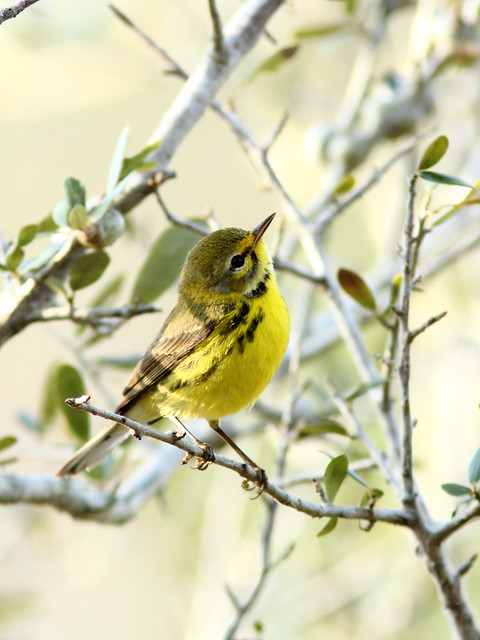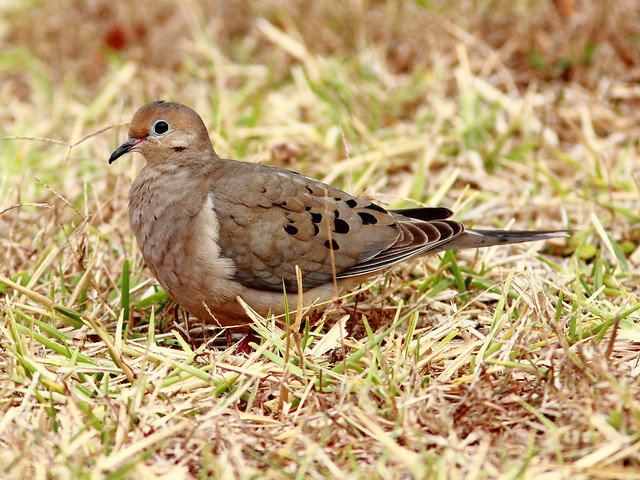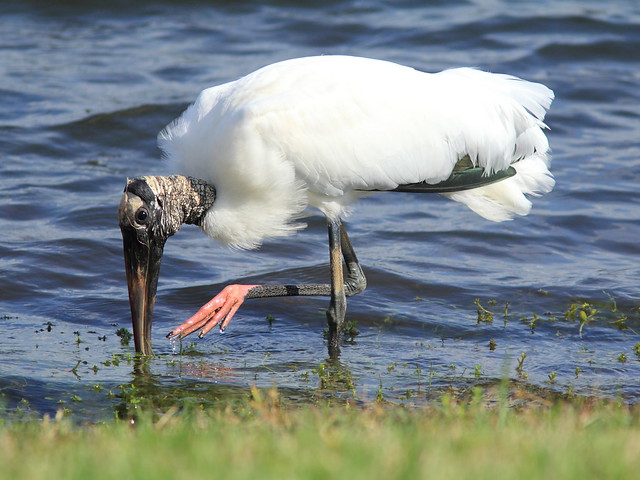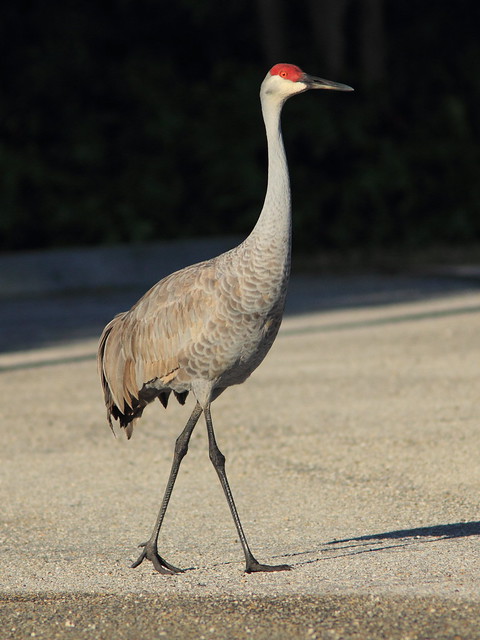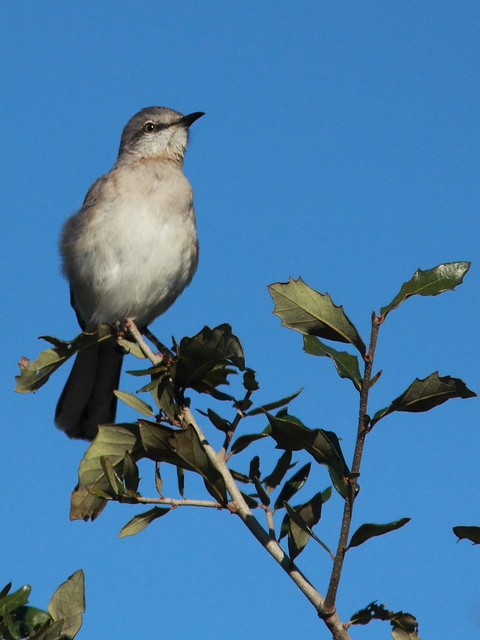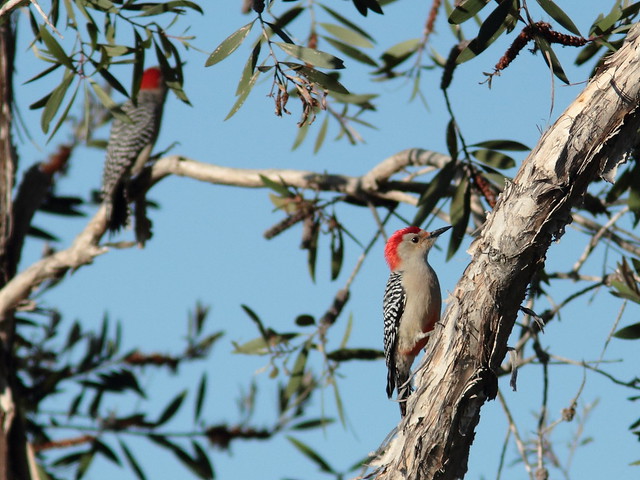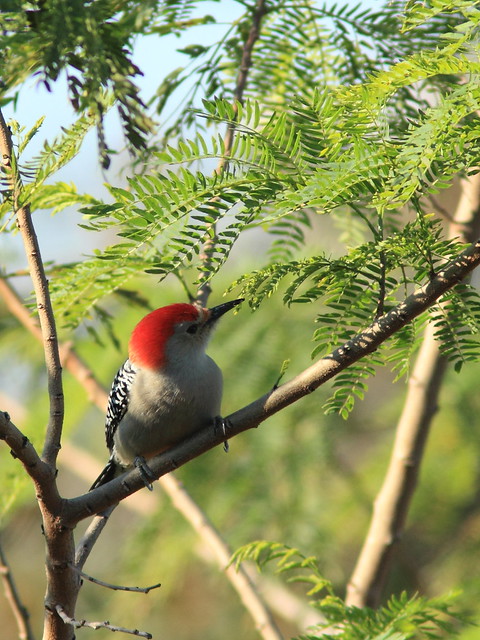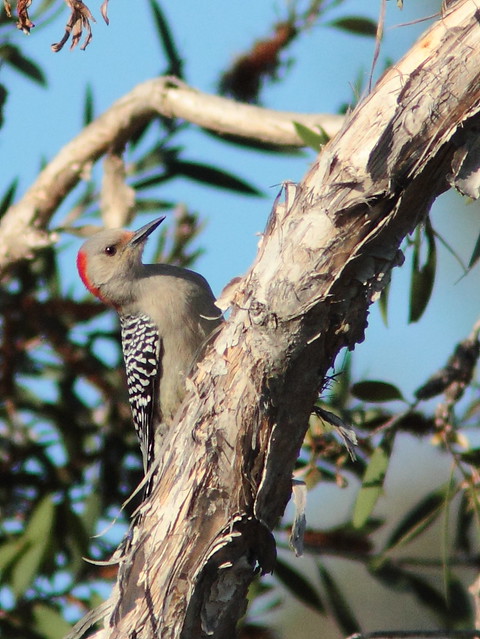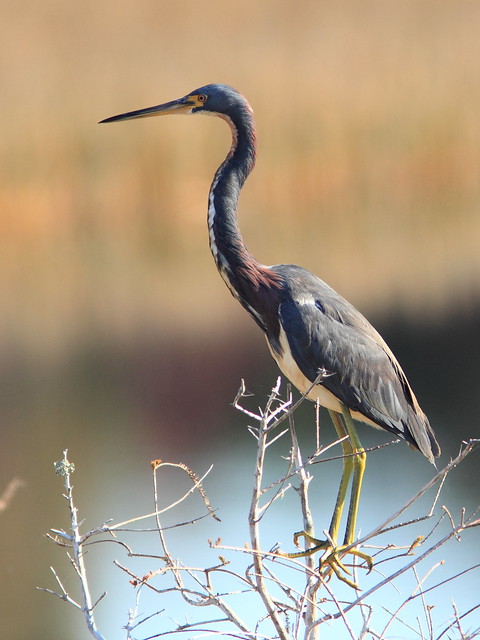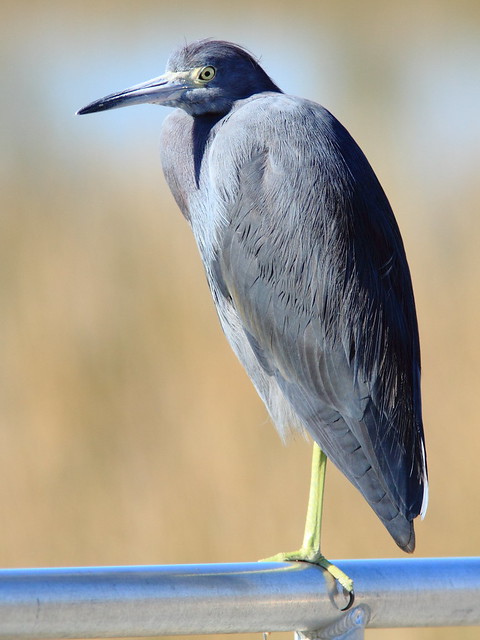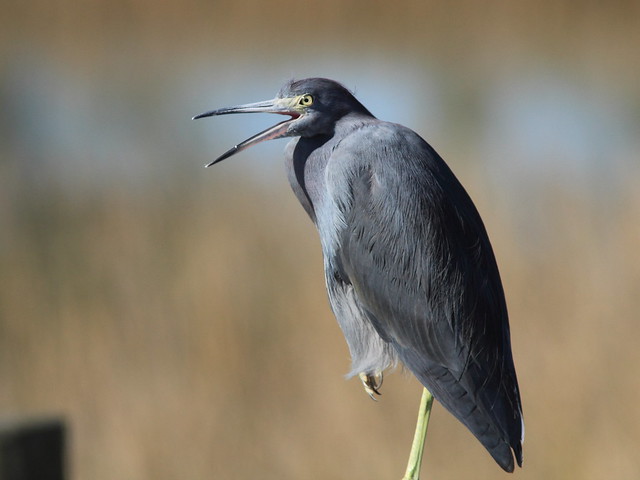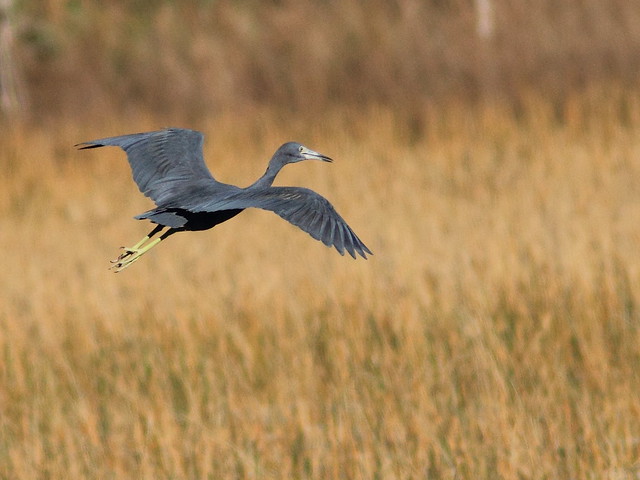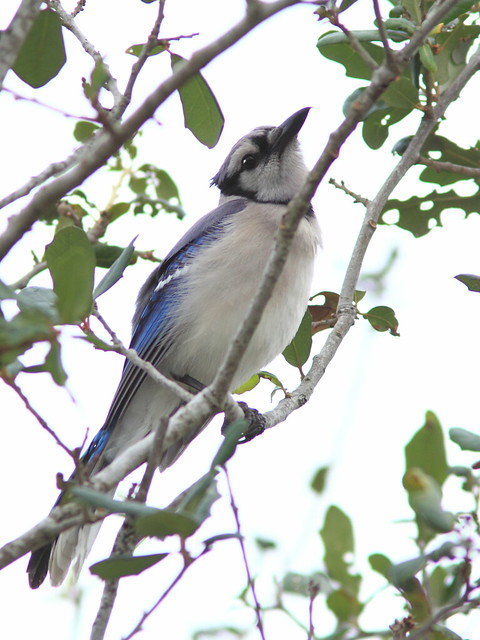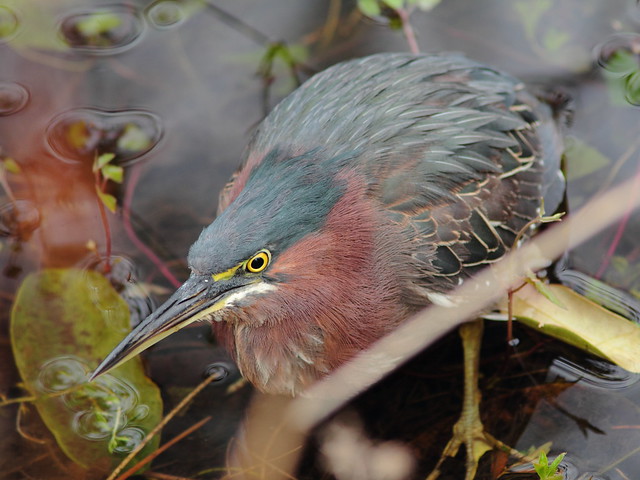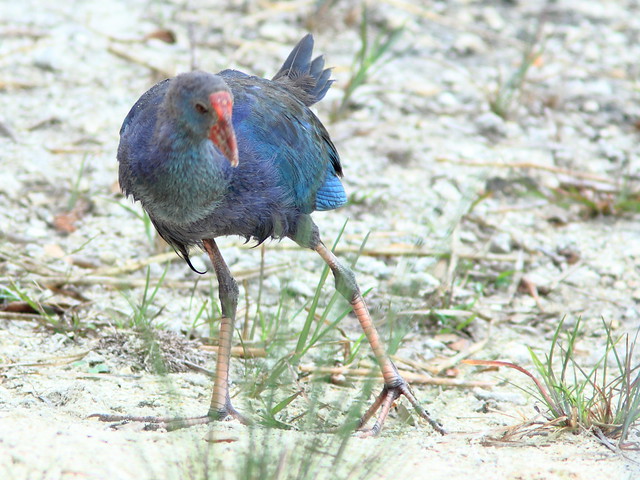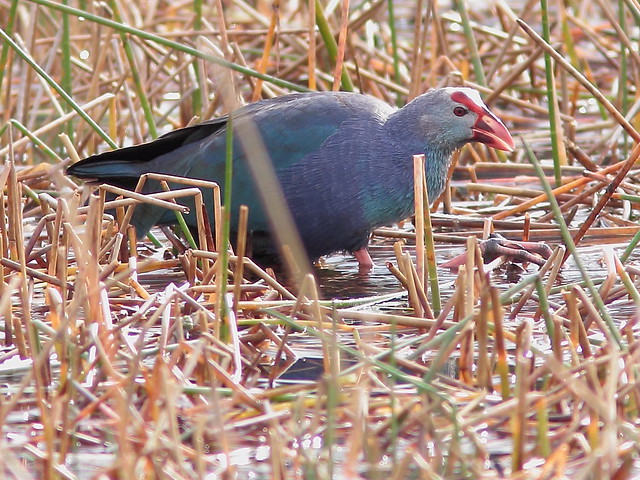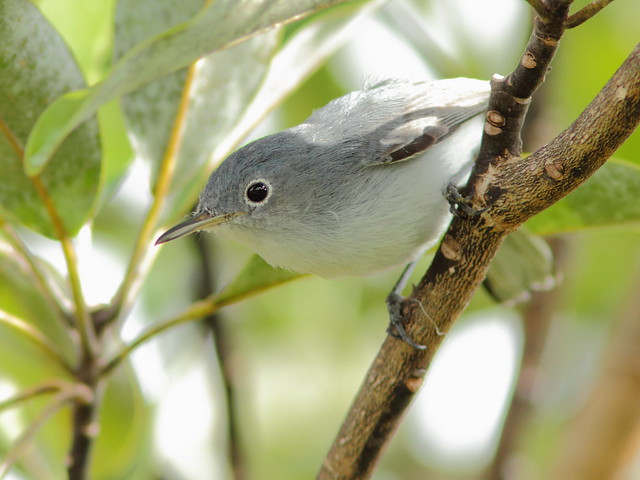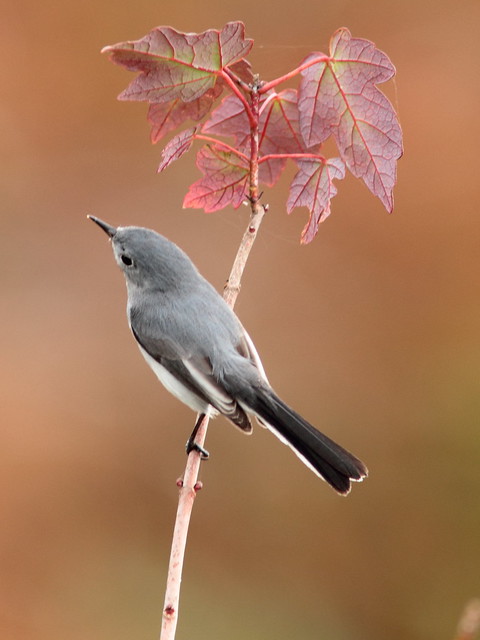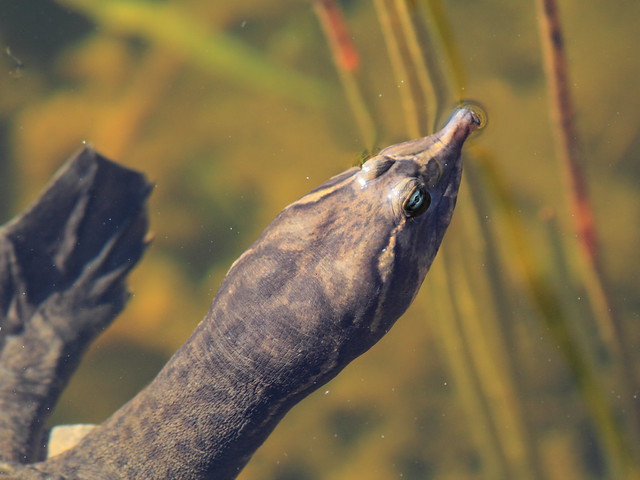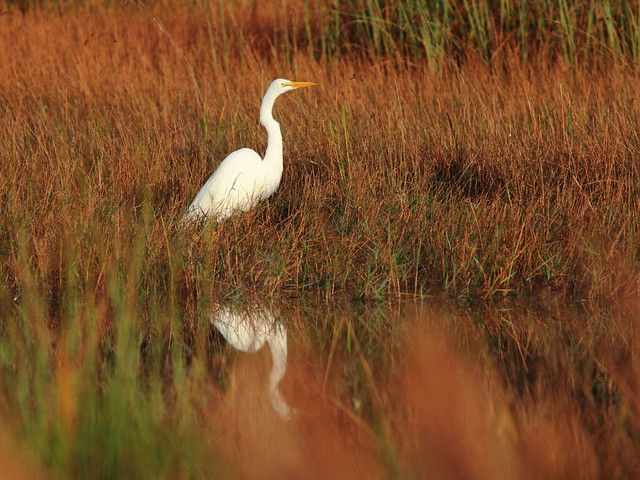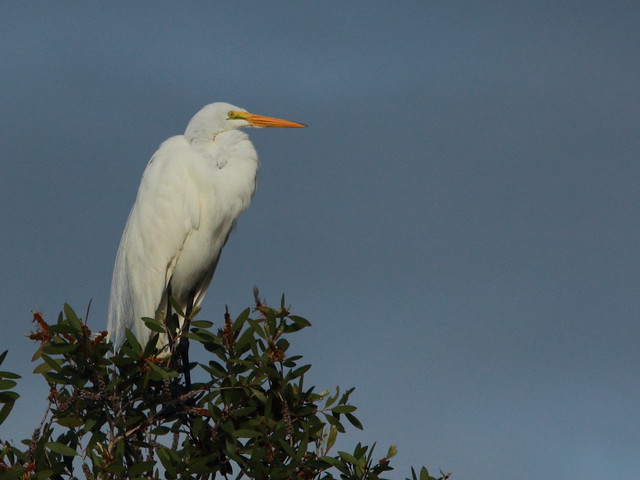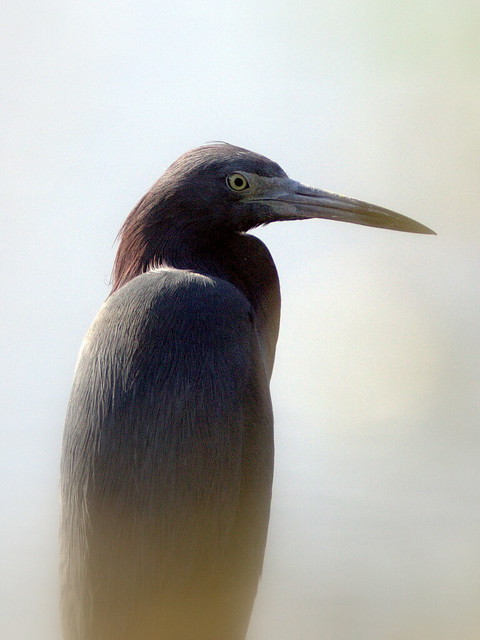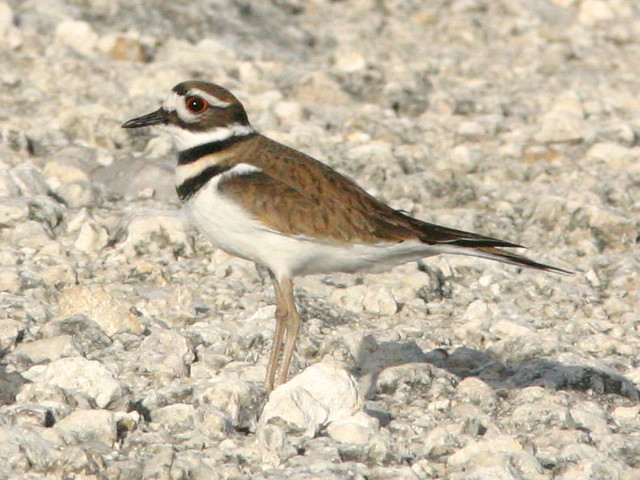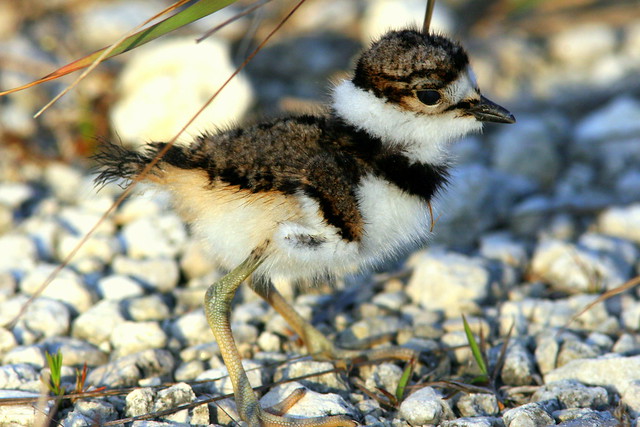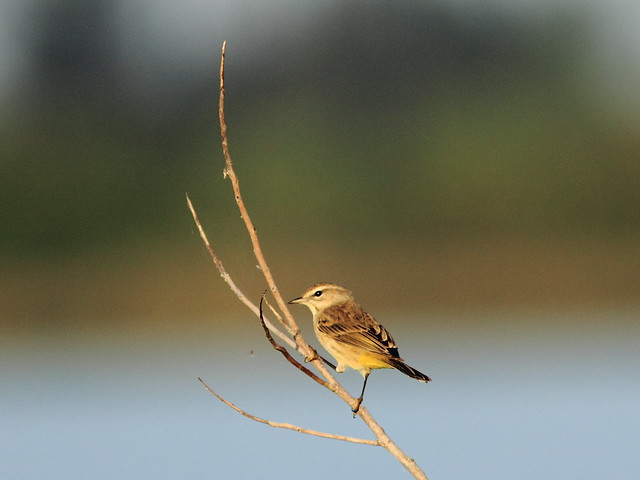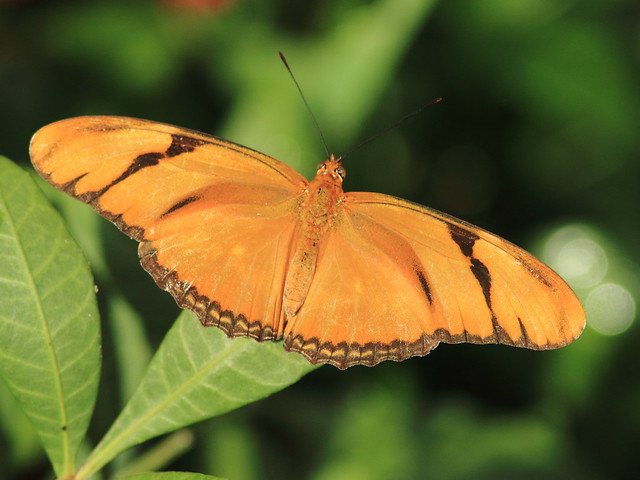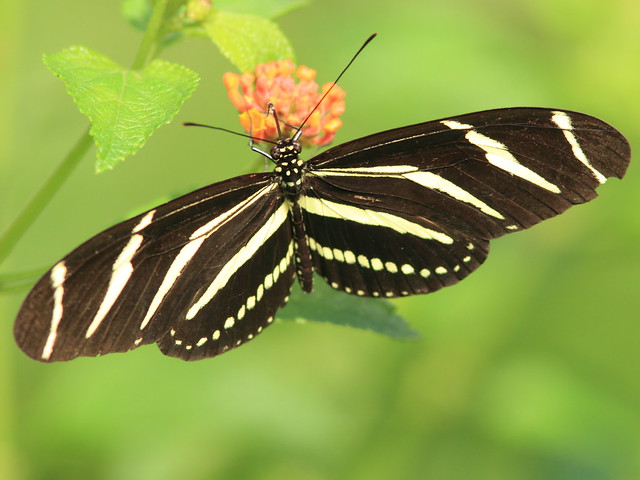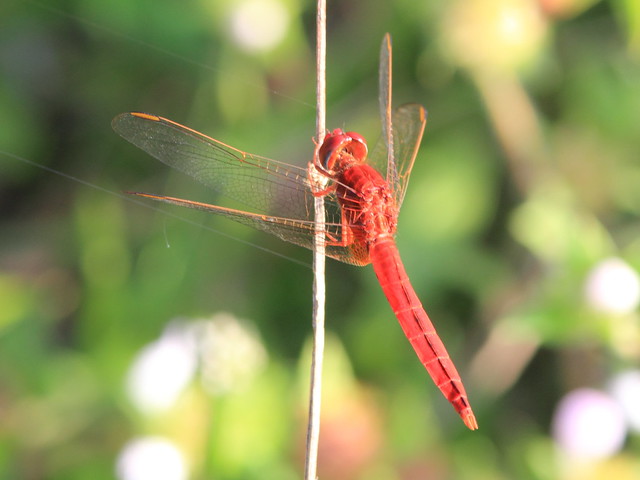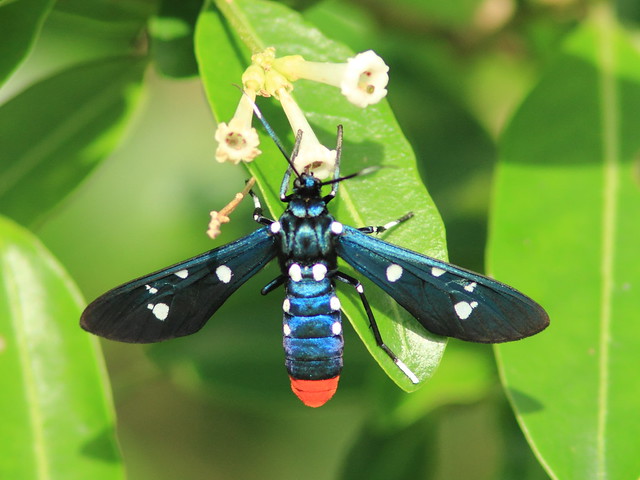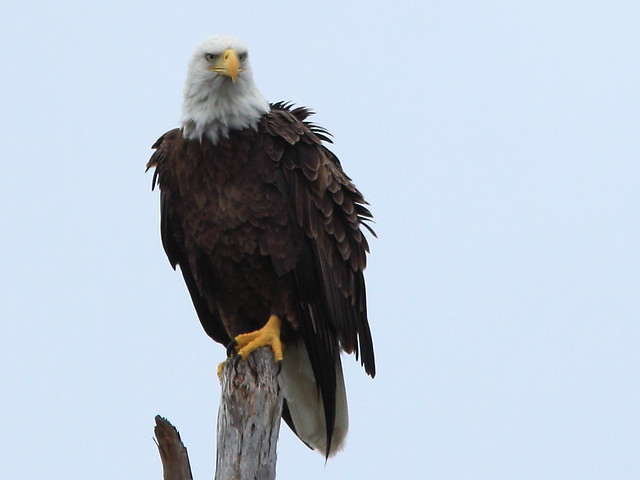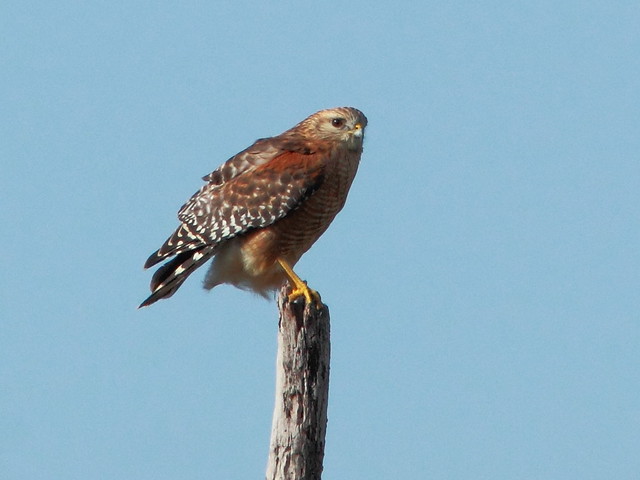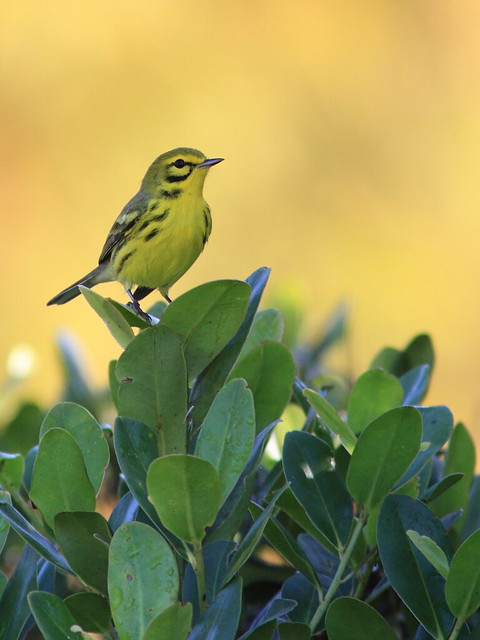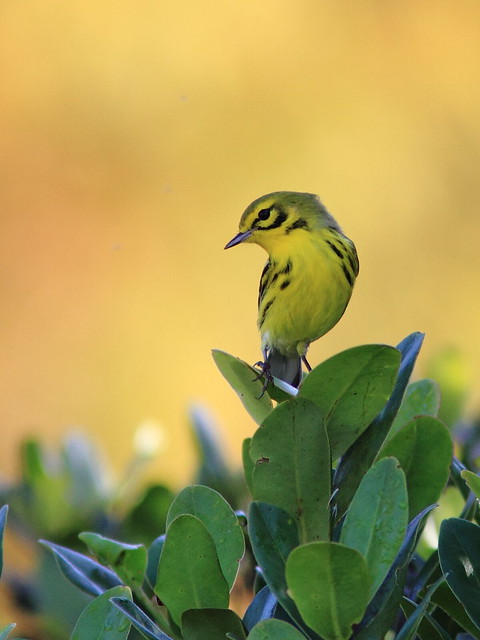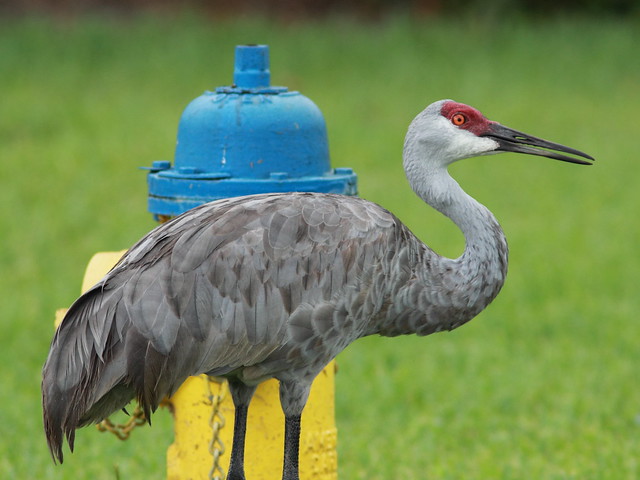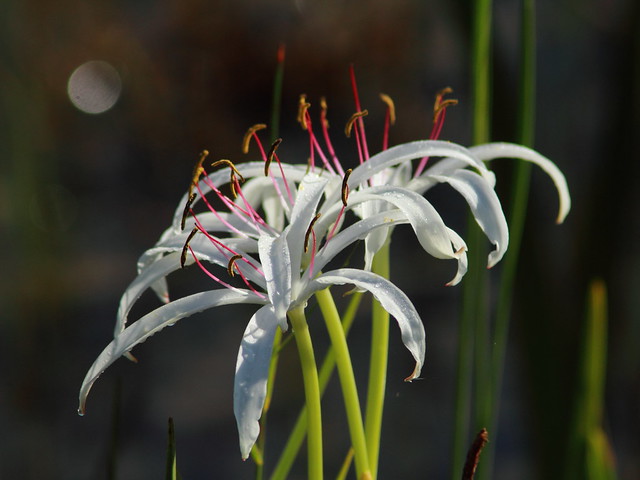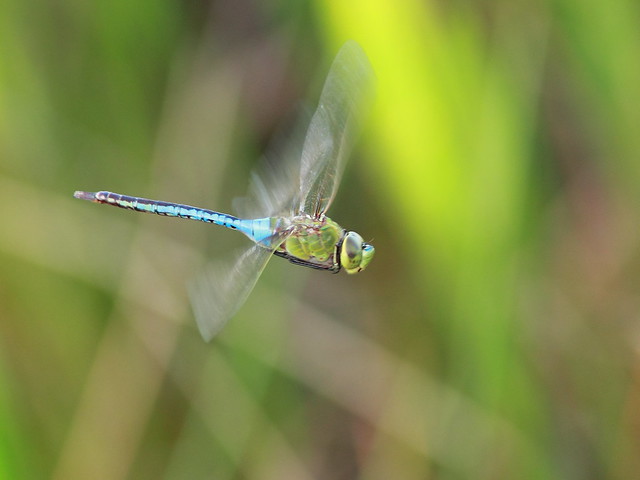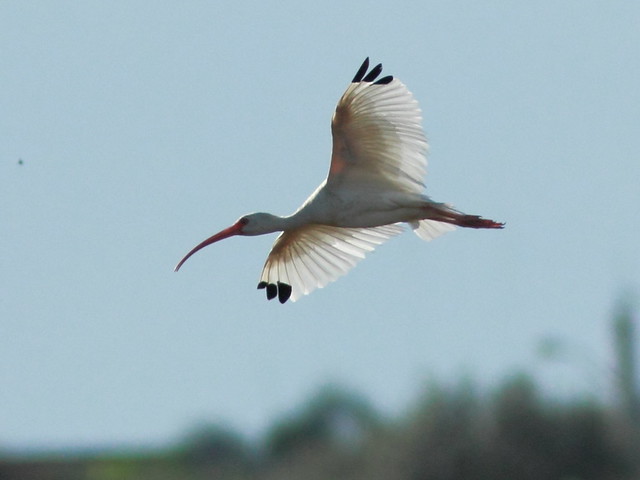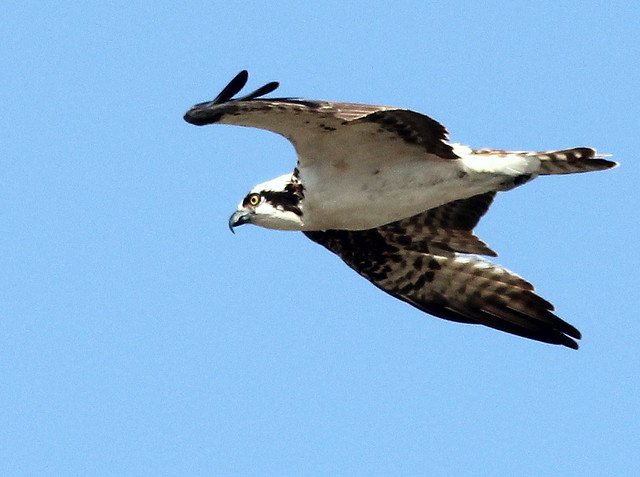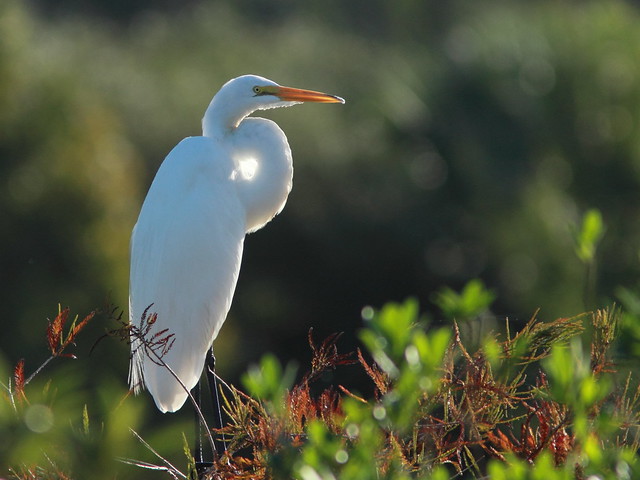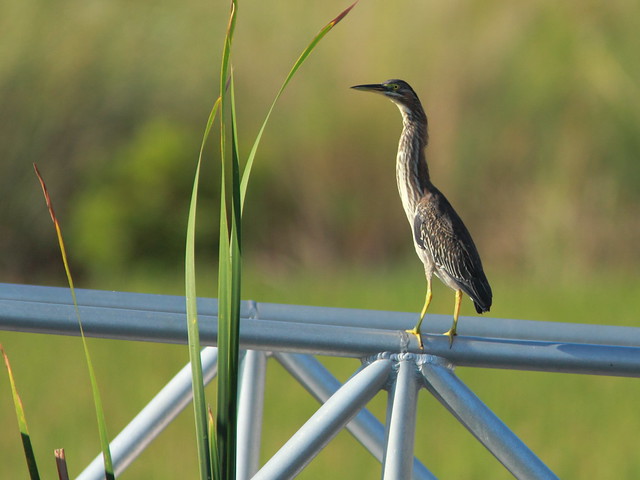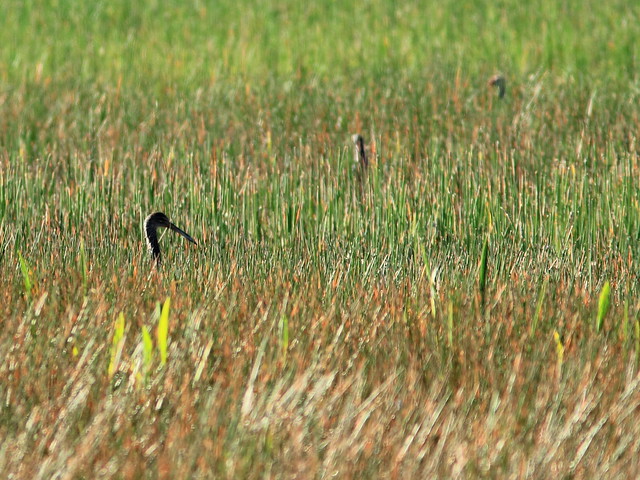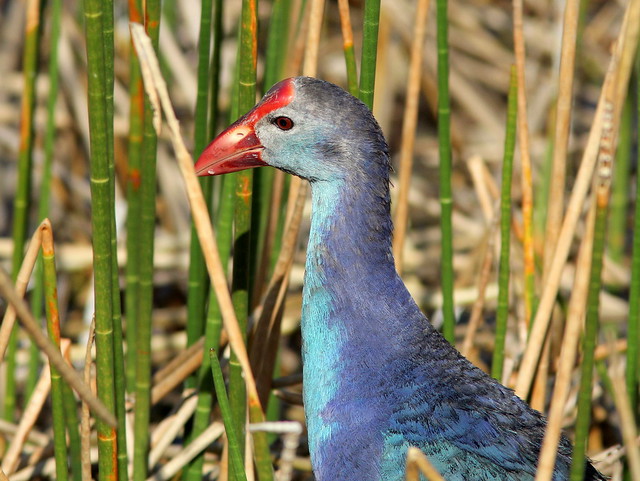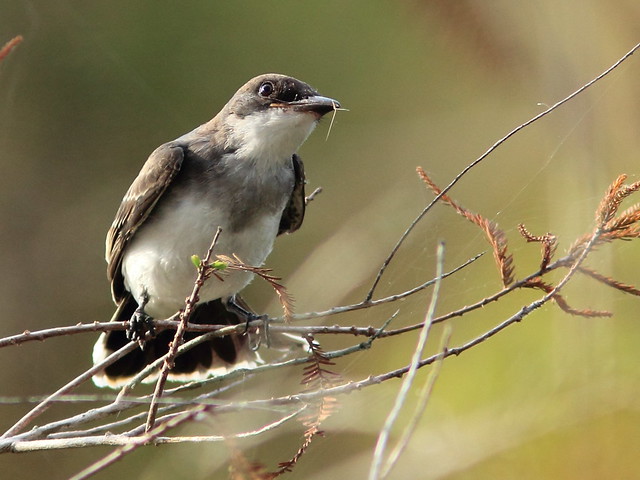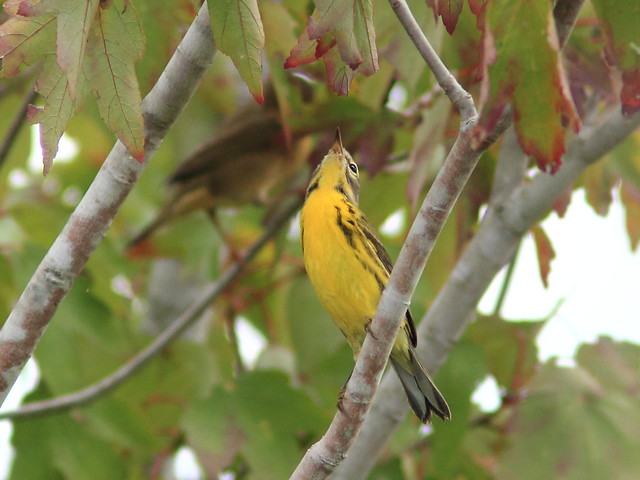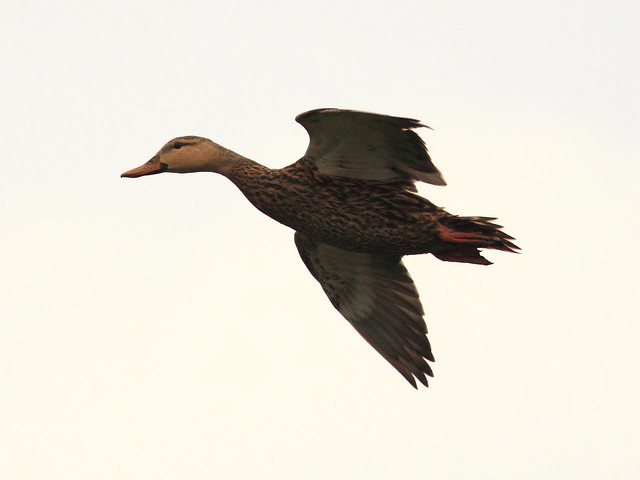Posted by: Ken @ 1:42 pm
This week we have spent a lot of time watching the local Bald Eagle nest. A 19 day old eaglet finally peeked over the rim on February 2.
Birding in mid-winter here in South Florida, we face some distractions. Small birds have so many places to hide, as most of our trees are evergreen. Even the deciduous trees such as maples not only hang on to their old leaves, but new leaves start growing in January. Cypress trees gracefully turn from green to yellow to golden and brown, perhaps going “bald” for part of a month before putting out new greenery.
Then there is the wind. On a still morning, it is easy to discern the tremble of leaf or twig, signaling the presence of a reclusive vireo or warbler. As the sea breeze builds, it scrambles the input to the rods in our corneas that normally alert us so efficiently to the slightest peripheral movement. Bazillions of fluttering butterflies vie for our attention.
Certain “non-target” species can also be distracting when I’m hoping to see Orange-crowned Warblers and Black-whiskered Vireos. Noisy Gray Catbirds and tail-wagging Palm Warblers abound all winter, and mockingbirds rattle around in the bushes. The antics of a flock of Blue-gray Gnatcatchers can keep you busy trying to separate them from warblers. Of course, just as is the case with chickadees up north, the gnatcatchers can keep very interesting company, so it is best to look at each one to rule out the 1% that is something more “interesting.”
Note that I avoided the harsh term of “trash birds,” sometimes used in an offhand manner by birders when they only see common species. I have written before about finding “Beauty in the Commonplace” as well as in some real “Trash Birds,” notably the exotic Sacred Ibis and the Purple Swamphen, both of which have been deemed a threat to native avifauna and have been subjects of eradication campaigns (dismally unsuccessful in the case of the swamphen).
One recent morning when a small flock of Blue-gray Gnatcatchers flew into the Trema tree where I was hoping to see something more “unusual.” I realized that I rarely get very good images of them. I don’t know how to make them stand still, and these birds were very active. Yet, despite their perpetual motion, they generally stayed in sight. The light was perfect. I focused my full attention on these little sprites, even ignoring the calls of nearby towhees and a White-eyed Vireo, and took over 50 photos. My trouble now is that I cannot bear discarding most of my shots. So I hope you can put up with an overdose of gnatcatchers.
This one stared at me quizzically…
…and came in for a better look.
Another climbed up a twig…
…and then treated me to a high dive.
I was delighted to catch a few flight shots, usually quite by accident.
This was my favorite flight shot, taken a couple of years back.
Two years ago, a gnatcatcher landed momentarily on a clump of invasive exotic Brazilian Peppers, providing me with my all-time luckiest image.
Well, I did finally break away from the gnatcatchers, or more correctly, they moved on as is their habit, and I started paying attention to my surroundings. This female Northern Cardinal gave me a red-on-red experience.
A Loggerhead Shrike called from a high perch.
At the site of our local rookery, an immature Yellow-crowned Night-Heron (most easily distinguished from the Black-crowned by its short and plump bill) had returned along with a more elusive adult,
A bright male Prairie Warbler hid in the berries at nearby Chapel Trail Nature Preserve, …
…and then came out into the open.
Back at home, a Mourning Dove rested on a neighbor’s lawn…
…and a Wood Stork showed off its bubble-gum pink feet at the edge of our back yard.
Posted by: Ken @ 6:37 am
This is the fourth winter that Mary Lou and I have been monitoring a Bald Eagle nest that is located only about 1 1/2 miles from our South Florida home. So far, they are known to have successfully raised eight eaglets since the spring of 2008. In a previous post we provided an overview of this, the first active Bald Eagle nest in Broward County since the 1960’s, before DDT was restricted. We organized a team of eagle watchers to monitor and help protect the nest, and I serve on a City of Pembroke Pines Bald Eagle Sanctuary Steering Committee that has helped develop changes in planning documents and recommended an ordinance to better protect this and any other nest from disturbances.
We visited the eagle nest Monday morning January 15. The first egg was laid on or about December 11, and this was the day we expected it might be hatching. When we arrived at about 8:30 AM we could see the top of the head of one adult bird deep down in the nest. The incubating adult tends to sit a bit higher, “tenting” any newly hatched chick, so we took this to be a sign that the first egg has not hatched.

The bird did move about, but never stood up during the hour or so that we observed the nest. A second adult flew and roosted on the horizontal limb above the nest, began calling excitedly and looking down at the nest. We do not think the bird on the nest called back. Our experience has been that such a change in behavior suggests that an egg may have indeed hatched.



Then the adult flew off to the east, only to circle behind the nest and take a roost in the dead Melaleuca grove west of the nest. It appeared to be the female, though we could not be certain.


A Red-shouldered Hawk was roosting just west of the nest tree.

A Great Egret flew over the nest, and I stitched together 15 sequential images. Here are a few.

Two days later (January 17), the incubating bird was more visible. Is it possible that she is indeed “tenting” a chick that has hatched? No other adult was in sight as we watched from about 12 noon to 1:00 PM.

Here, the adult (female?) is peering down underneath her– is she rearranging eggs or tending to a hatchling? Her head and sometimes part of her back and tail remained visible the entire period of observation, something that had not happened since the eggs were laid.

On January 22 we were treated to the sight of a small falcon that flew in and roosted just west of the Bald Eagle nest tree. It made two flights out and returned to the same tree. Its wingbeats were energetic and it flew fast and directly. It was heavily streaked and its profile showed its head to be smaller than an American Kestrel’s. It had one whisker stripe and no strong face pattern as seen in a female kestrel. It appeared to be an immature Merlin. Photos are from about 200 feet, so they are not very sharp.


Mary Lou and I continued watching the nest almost every day, and saw definite signs that the egg had indeed hatched, such as the presence of prey in the nest and feeding of one or more eaglets. On Thursday morning (January 26) we watched from about 10:30 until about 11:15. When we arrived the female was roosting on the right edge of the nest, looking about and appearing restless.

Mary Lou correctly guessed that she was awaiting a food drop, as within a few minutes the male flew in with a medium sized fish that looked like an exotic Mayan Cichlid, a common fish in local lakes.



The pair called to each other and touched bills in a sort of recognition ritual, and the male (on the left) flew off.


The female tore at prey and fed one or more eaglets. We still could not see the eaglets over the rim of the nest– we assume the nest cup is a bit to the rear. In past seasons the young have appeared over the nest rim at between 12 and 23 days of age. If our behavioral observations are correct, hatching occurred on January 15, and the first eaglet would be 11 days old this day.


Turkey Vultures must now be smelling the prey, as a couple of them circled several times close around the nest tree. In the past we have seen the eagles chase them off.
On Friday morning (January 27) an adult was quiet on the nest and there was no sign of its mate as we watched for about 3/4 hour from 9:30 to 10:15 AM. The oldest chick was then about 12 days old. A front page story about Florida’s urban eagles appeared in the paper that morning, with a quote and a slide show of some photos of me and other eagle watchers.

Of interest, a male Northern Harrier flew over the nest area. Mature males, which are gray and white with black wingtips, are outnumbered 8 or 12 to 1 by the larger brown females and immature birds, so it is a treat to see one.

A flock of Fish Crows chased a colony of Monk Parakeets away from their nest on a high light pole across the street from the eagle nest. I thought they were looking for eggs or young birds to eat, but instead they stole twigs, presumably to use on their own nests. Fish Crows can be predators on the very young eaglets.

Saturday (January 28) morning we checked the nest, hoping to see one or more chicks peeking over the rim of the nest. The first-hatched should be about 13 days old. At 8:15 AM the female was quiet and rather low in the nest, so we assumed that the chick(s) had been fed and were probably sleeping. We note that when a food drop approaches the hen stands high and gets restless. Therefore we went birding at Chapel Trail and returned at about 9:30 to find the male roosting in the nest tree on a horizontal limb above the nest. We had probably just missed the food drop.

Note the slimmer and more tapered body of the male. His bill also appears to be a bit less massive than that of the female. This year he does not have the dark streaks on the outer tail feathers that helped us distinguish him the past two seasons. The power lines just in front of the nest are one of the hazards faced by urban-nesting eagles.

The female was active, tearing at prey and feeding the the chick(s). I think we had just missed a prey drop. About 10 minutes after our arrival the male flew away low to the west.

The female remained on the nest for less than 5 minutes before flying over to roost on a Melaleuca snag just to the west.
She is noticeably larger and rounder than the male.



She flew back to the tall pine just west of the nest and roosted a few minutes, then settled back on the nest. The nest was left unguarded for about ten minutes. This rarely happens when the chicks are less than two weeks old. See the Eagle Milestone spreadsheet which chronicles observations over the past four breeding seasons (PDF). This was the first time this season we witnessed the nest uncovered and without a lookout nearby.
Posted by: Ken @ 12:07 pm
During the busy holiday season we made time for brief birding stops at nearby Chapel Trail Nature Preserve in Pembroke Pines, Florida.
One sunny morning just before Christmas, the Sandhill Crane greeted us in the parking lot.
The crane permitted me to take a close-up as it preened.
A Northern Mockingbird stood out against the blue sky.
Red-bellied Woodpeckers were courting in a Melaleuca tree.
The male exhibited his bright red cap.
The female’s cap is just as bright, but does not extend down her forehead.
This Tricolored Heron roosted in a very small tree next to the boardwalk.
A Little Blue Heron perched on the rail of the canoe dock.
The heron then assumed some interesting postures before flying off
This morning, on our way back home from running chores we stopped by again before checking on the Bald Eagle nest that is about a mile away. The sky was fully overcast and there was the threat of rain, so we did not walk the full length of the boardwalk. The crane was not in the parking lot this time. We worry about its welfare, as it has a habit of walking across the busy street in front of the nature center. Peering down from a small tree in the lot, a Blue Jay’s colors seemed to be more vivid in the subdued light.
Just under the entrance bridge, a Green Heron stood motionless in the shallow water. It was still there when we left a half hour later.
Along the shore of the first lake, two immature Purple Swamphens foraged on dry ground.
The adult Swamphen was picking through the floating vegetation.
We encountered a flock of Yellow-rumped Warblers and several Blue-gray Gnatcatchers. The gnatcatchers were in perpetual motion. I took many pictures of bare branches and blurred wings.
One gnatcatcher stood still long enough for me to capture it on a maple twig. The cypress trees in the background have turned mostly to reddish brown and should lose their needles within the next few weeks.
A Soft-shelled Turtle with beautiful eyes swam by.
At the eagle nest, we again found an adult incubating deep in the nest, barely in sight. The first egg was laid on December 11 and is expected to hatch 35 days later, on January 15th.
A Great Egret was fishing in the canal in front of the nest.
Strike!
Posted by: Ken @ 7:40 am
It’s best to approach each day in the field with expectation and a sense of wonder. That way, even if birding is slow, you will not be disappointed, and will find beauty in the commonplace. One morning last week was no exception. Just before sunrise, the sky held the promise of a few showers, but the radar showed none headed our way. An unexpected phone call and the need to address a friend’s health concerns made us over an hour late for our walk.
It was too late for me to look for the Bobcats, as they usually are only out around sunrise. In a way this was a blessing, as I have become rather obsessed with getting better photos of the adult and her two cubs, and feel compelled to get out while it is still dark, and then wait for about a half hour for them to show. In the meantime, Mary Lou usually goes on without me. More often than not I fail to see them, and I’m missing out on the “power walk” that normally precedes my photo sessions. So, this morning we got in our walk, at least the first half, before I started falling behind and exploring.
The usual Great Egret was foraging in the wet prairie next to the gravel road that accesses our local patch of wetlands.
The egret flew to a treetop, probably waiting for us to continue on down the road.
This Little Blue Heron peered out through the lakeside vegetation. I was going to trash this shot until I realized that its eyes were in good focus.
Birding turned up nothing unusual. A pair of Killdeers were moving along the road in their usual run and stop, run and stop fashion. I’m hoping they plan to stay and raise a family this spring.
Here is one of the Killdeer chicks from a previous season.
Palm Warblers, their long legs an adaptation for foraging on the ground, flew up into the roadside shrubs as we passed by.
When the birds are not out and about, it is much easier to notice the butterflies and dragonflies. Julia longwings (Dryas julia) were out in large numbers. This is a fresh male.
Female Julias are almost always tattered and torn, damage probably inflicted by competing males. It was a bit unusual to find a nearly perfect specimen.
Closely related Zebra heliconians (State Butterfly of Florida with the musical scientific name of Heliconius charitonius) congregated on a Lantana in full flower.
A colorful exotic Scarlet Skimmer (Crocothemis servilia) perched on a twig. An Asian native, it was accidentally introduced to Florida and Hawaii, probably on potted plants.
Walking home, a large and angry-looking wasp-like insect almost flew in my face. I had never before seen such a creature. Was it new to science? It looked “armed and dangerous.” I cautiously approached it to document it for later identification. I was amazed to learn that it was not a wasp at all. It was a Polka-Dot Wasp Moth (Syntomeida epilais).
a diurnal moth that does a great imitation of a wasp. Its appearance
acts as a warning to predators. While it does not sting, it is poisonous
due to its diet as a caterpillar.
Later, I showed this photo to Graciela, our seven year old granddaughter who had just arrived from Chicago, asking her if she thought this “wasp” could sting her. She nonchalantly said, “Oh, Grandpa, that’s not a wasp, it’s a butterfly!” I was amazed and asked her how she knew that. She said she learned it on “Wild Kratts,” a childrens’ nature show on TV. She added that it was an example of mimicry that makes a harmless insect look like a poisonous one. Elaborating on this, she said that some butterflies mimic Monarchs to look as if they are poisonous too. Rather timidly, I mentioned that this was actually a moth, not a butterfly. She looked closely at the photo and said that a moth has feathery antennae, which this one lacked!
I hurried to catch up with Mary Lou, as we had to do some shopping in
preparation for the arrival of house guests. The drive to Wal-Mart
provided us the opportunity to make a couple of brief stops, to check
out the local Bald Eagle nest and also visit nearby Chapel Trail Nature
Preserve.
Our local eagles have set up housekeeping in the same nest that we now have been observing for five breeding seasons. We are quite certain that the first egg was laid on December 11, when the female suddenly started sitting low in the nest. Two days before, I captured this image of her roosting near the nest.
When we visited on December 16, I first thought the nest was empty, but after about 15 minutes the female stood up to change position and also probed down underneath her, probably to rearrange one or more eggs.
A Red-shouldered Hawk roosted near the eagle nest.
At Chapel Trail, birding was also quiet. We turned up a couple of common species, but this male Prairie Warbler was uncommonly beautiful as it perched against a backdrop of Cypress trees that were just beginning too turn golden brown.
For a searchable index of earlier ROSYFINCH RAMBLINGS posts, follow this link
Posted by: Ken @ 6:25 am
In an earlier post I described the creation of Chapel Trail Nature Center and its near destruction when vandals set the boardwalk on fire shortly before its planned grand opening. It had been open less than a year when Hurricane Wilma toppled most of the boardwalk. Earlier this month, soon after we returned to Florida from our second home in Illinois, we visited the preserve, located nearby in Pembroke Pines. It was a rather dull morning for birding. There had been plenty of rain, and flood water had diluted out the fish so that the long-legged waders were no longer concentrated there. We started out late and it became progressively more hot and muggy.
The resident Sandhill Crane greeted us at the parking lot…
…and posed next to a fire hydrant…
..but otherwise it seemed that the paraglider overhead and the insects and flowers around us would be the best sightings of the day: 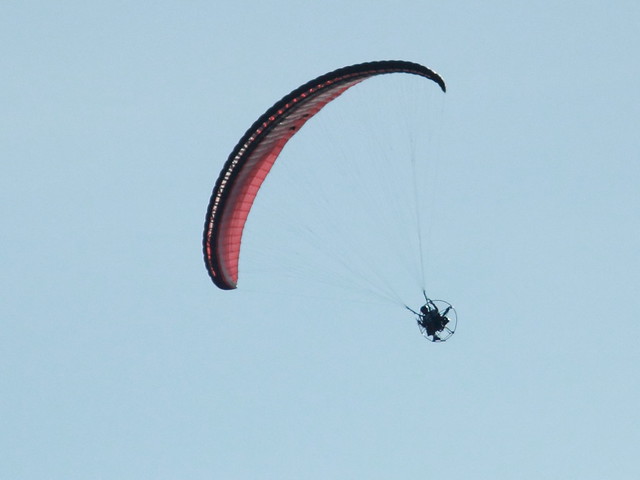
Spiny Orb Weaver:
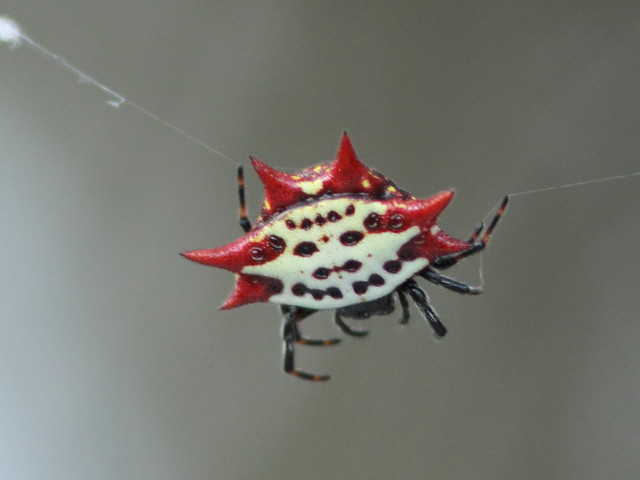
This photo was marred by a single bokeh that took on the appearance of a full moon, but I decided that it looked in balance with the image of the Swamp Lily:
There were two of these little green-eyed blue-bodied black-tipped dragonflies. about 1 to 1 1/4 inch long– too small to be Eastern Pondhawks, so I at first was not sure of their ID. There is a midge on this one’s back. Interestingly, one species of dragonfly, Sympetrum, has antibodies against its midge parasite (Arrenurus planus). When the midge bites into the dragonfly, its piercing mouth parts turn bubble-like and the parasite dies. Midges are used to control certain insect pests (Reference).
Blue Dasher– look closely to see the midge, or click on the photo to see the note: 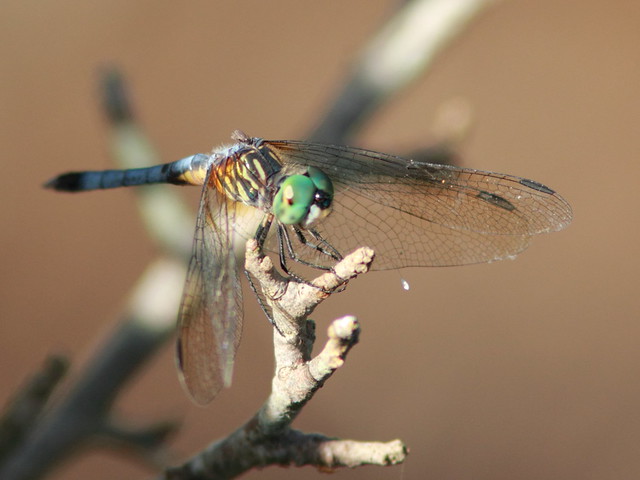
A Green Darner rarely perches. This guy would not stop flying, but did hover in place long enough for me to get the center point focus on him. If I had planned this shot I would have increased shutter speed greatly:
The resident Red-shouldered Hawk watched us from it perch in a small tree: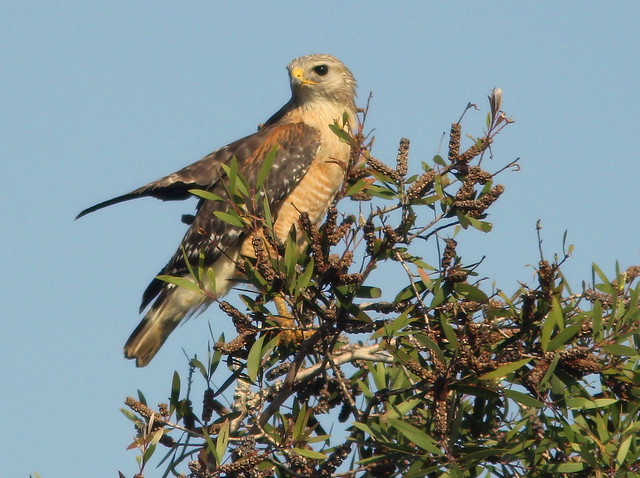
A lone White Ibis flew overhead…
…as did an Osprey:
From the boardwalk, Mary Lou scanned the wetlands :
A Great Egret was nicely back-lit by the early morning sun:
A Green Heron stood on the rail of floating boat dock at the far end of the boardwalk:
Then, the head of a Limpkin appeared above the marsh vegetation (I did not notice the two Purple Swamphens, out of focus behind it and to the right):
The bird flew up and passed directly in front of us on the way to a roost in the small island: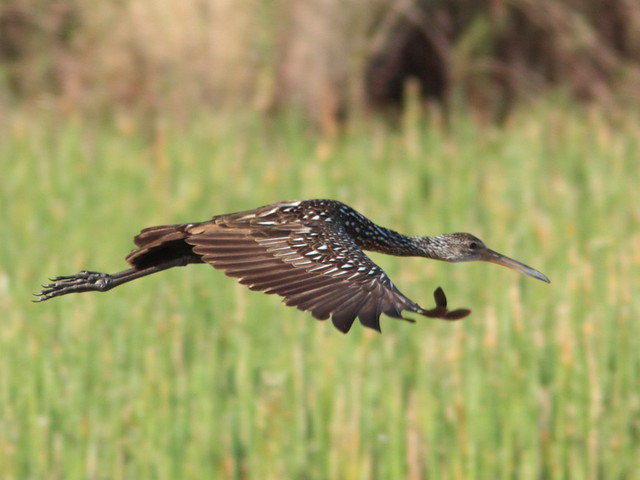
Purple Swamphens seem to get more numerous every week at Chapel Trail. As we walked along the boardwalk, there were 2 to 3 in view at all times. We saw no gallinules or moorhens, which is a bit disturbing– their young are said to be food items for the invasive introduced swamphen:
We also saw a half dozen Eastern Kingbirds:
Many of the Eastern Towhees that breed in far southern Florida have yellow rather than red eyes: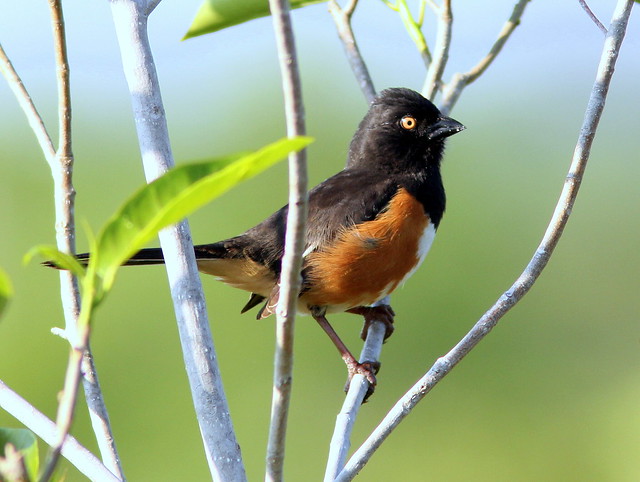
A Common Yellowthroat foraged in the Red Maple leaves, already starting to change color:
The yellowthroat was joined by a Prairie Warbler:
Yesterday morning we got out just before a big rainstorm curtailed our walk. The leaves of the Red Maples had already gone from red to brown. We found that Palm Warblers had arrived in good numbers. They become so numerous during the winter that locals call them “Florida Sparrows.” During fall migration, the brightly colored eastern Yellow Palm Warblers cross paths with the dull western form, and winter more to the west, from northern Florida into east Texas.
This is a representative of the dull Western race, much more commonly seen than the bright eastern form:
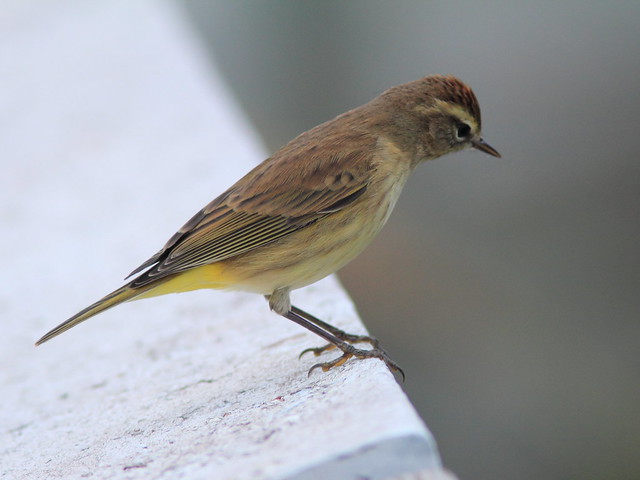
Despite the dark skies, this Boat-tailed Grackle’s iridescent coat reflected many hues of blue:

It was starting to drizzle as a Mottled Duck flew overhead:
On the way out, I stopped to photograph a Little Blue Heron that was walking along the canoe dock: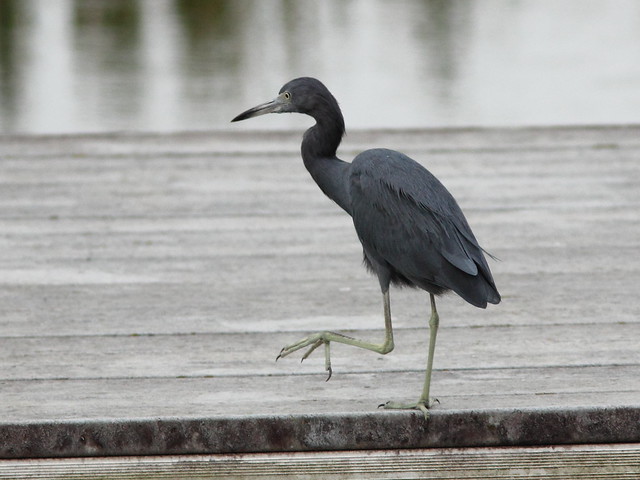
A Marsh Rabbit watched us warily as we exited the boardwalk.. This semi-aquatic race of Cottontail has a darker coat and very short ears: